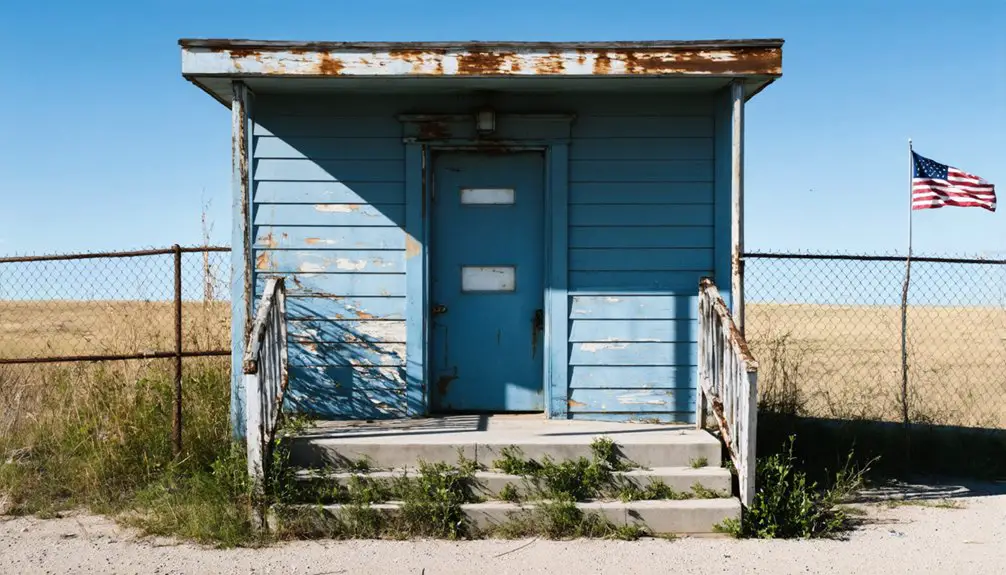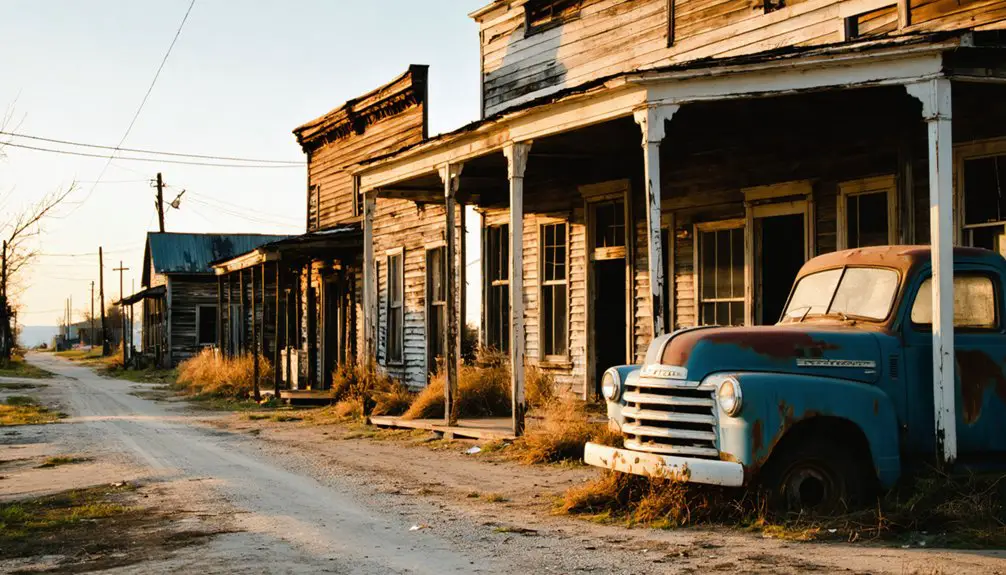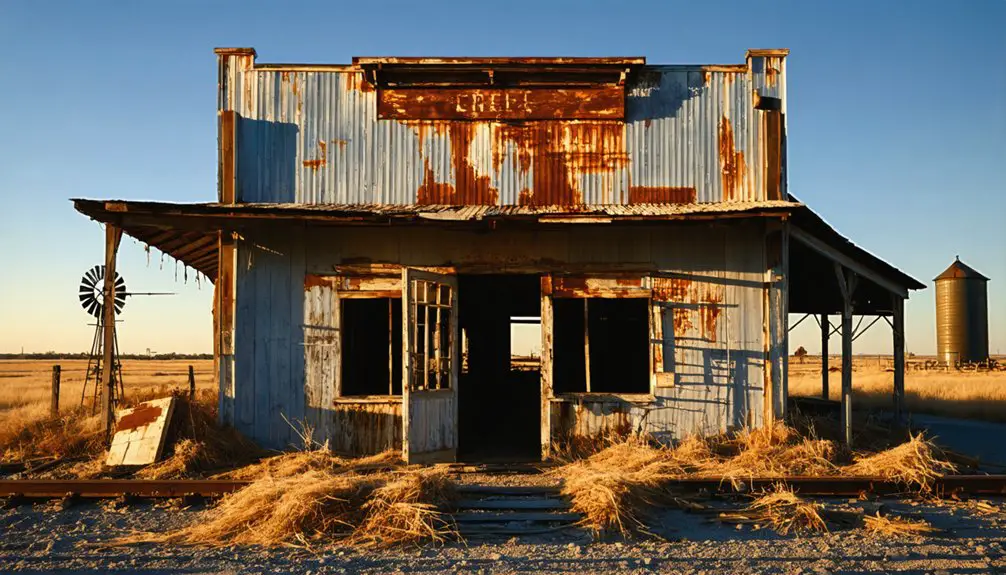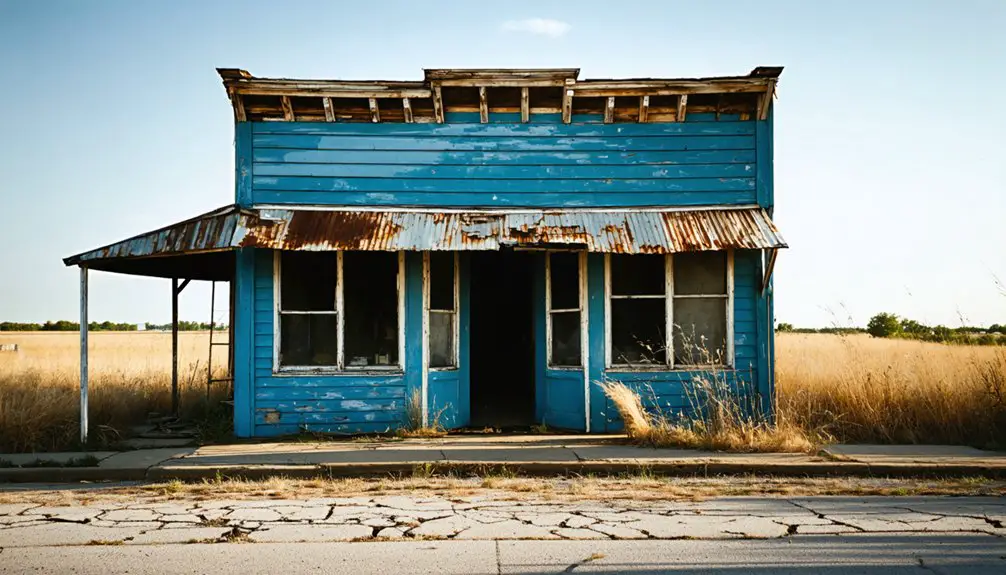You’ll find Fowlerville’s roots in Oklahoma’s 1889 land run, when pioneers Wells Fowler and William Taylor established this frontier settlement in the Unassigned Lands. The town quickly grew to 400 residents, with essential infrastructure including stores, churches, and a post office serving the diverse community. While railroad bypasses and declining commerce led to its eventual abandonment, Fowlerville’s five surviving buildings and archaeological sites hold fascinating stories of Oklahoma’s boomtown era.
Key Takeaways
- Fowlerville was established in 1816 by Wells Fowler and William Taylor, reaching a peak population of 375-400 residents during its founding period.
- The town’s decline began when railroads bypassed it, leading to economic isolation and deteriorating trade connections.
- Population decreased by over 80% as younger residents left, while key businesses and the post office eventually closed.
- Archaeological evidence reveals thirty original buildings, with five main structures surviving, including barracks and employee quarters.
- The ghost town’s remains showcase Oklahoma’s boomtown era and early 20th-century resource-driven development patterns.
Early Settlement and Town Establishment
When the federal government opened Oklahoma’s Unassigned Lands for settlement in 1889, Fowlerville emerged as one of many hopeful communities within this two-million-acre expanse.
You’ll find its roots deeply connected to the dramatic land run that brought an estimated 50,000 settlers racing to claim their piece of the territory.
The town’s location was strategically chosen near railroad access points, following settlement patterns that defined successful communities in the region.
Access to railroads shaped frontier towns like Fowlerville, as strategic positioning near transportation routes often determined a settlement’s success.
Like many frontier towns, Fowlerville’s establishment faced challenges from competing land claims and townsite surveys.
You’ll understand how the newly created land offices played a vital role in sorting out legitimate claims from “sooner” entries.
While white Americans made up most of the early settlers, they weren’t just farmers – many came seeking opportunities in town-building and commerce.
The region attracted diverse ethnic groups, with Czech immigrants establishing communities throughout the territory.
The Homestead Act of 1862 allowed settlers to gain full ownership of their 160-acre plots after five years of living on and improving the land.
The Founding Fathers: Wells Fowler and William Taylor
Two ambitious pioneers, Wells Fowler and William Taylor, established Fowlerville in 1816, laying the groundwork for what would become a thriving frontier community.
As founding partners, they took on complementary roles in shaping the settlement’s early development, with Fowler’s name ultimately gracing the town itself.
You’ll find their founders’ roles reflected in the strategic infrastructure they created. They established two churches for spiritual and social cohesion, two stores for commerce, a hotel for travelers, and a post office for essential communications.
These carefully planned amenities demonstrated their commitment to building more than just another settlement – they envisioned a sustainable community.
Their community legacy lives on through historical records, even though Fowlerville has since become a ghost town.
Their pioneering spirit set the foundation for years of frontier prosperity, much like how small town pride drove Dalton Roberts and Adam Coon to their Olympic Trials victories.
The settlement grew quickly and reached a population of 375 to 400 residents during its founding period.
Daily Life in 19th Century Fowlerville
Life in nineteenth-century Fowlerville revolved around the rhythms of frontier farming and community cooperation.
You’d start your day at dawn, tending to crops and livestock before tackling daily chores like hauling water from wells or gathering firewood for your wood-burning stove. Your simple log home would include a kitchen garden where you’d grow vegetables to supplement your family’s diet.
During harvest seasons, you’d join your neighbors for collective work efforts, sharing tools and labor. Community gatherings at the local church provided essential social connections and learning opportunities. Similar to the Hunter’s Home plantation, residents maintained gardens and field crops to sustain their families. After severe weather events, neighbors would band together to help repair storm damage, just as they did in 1991.
Neighbors banded together during harvest time, sharing both the workload and fellowship while building lasting community bonds.
Women would preserve food through smoking and salting while men cleared land and repaired equipment. Your children would learn practical skills early, contributing to household tasks and farm work.
Winter months allowed time for indoor crafts and equipment maintenance.
Commercial and Religious Infrastructure
You’ll find Fowlerville’s early business district bustling with shops and services that lined the main thoroughfare, establishing the economic foundation of this mining community.
The town’s churches served as essential social hubs beyond their religious functions, bringing residents together for both worship and community gatherings near the town center. Like other mining towns of the era, the community experienced significant growth reaching peak employment levels of over 11,000 workers in the 1920s. Similar to Keyes, the town’s development was heavily influenced by the arrival of the local railroad which spurred initial growth.
The post office emerged as a significant connecting point for residents, coordinating mail delivery and facilitating communication between Fowlerville’s miners and their families outside the community.
Early Business Development
When Wells Fowler and William Taylor established Fowlerville in 1816, they quickly developed crucial commercial infrastructure to serve the growing frontier community. Their business partnership laid the groundwork for two competing retail stores, giving settlers choice in where to purchase their daily necessities and supplies.
You’d find the town’s post office serving as a crucial communication hub, connecting residents to the outside world through mail service and news delivery.
Like many Oklahoma settlements that emerged during this era as liquor towns, Fowlerville attracted customers from neighboring dry territories seeking alcohol.
Similar to the eventual fate of nearby towns like abandoned structures, only remnants of the original buildings remain today. The local hotel provided accommodations for traveling merchants and visitors, supporting the flow of commerce through the settlement. These early establishments reflected the town’s self-sustaining economy, built on agricultural trade and frontier commerce typical of Oklahoma settlements.
The retail competition between the two stores helped guarantee fair prices and diverse inventory for the community’s growing needs.
Churches Shape Community Life
As Fowlerville took shape in 1816, two churches emerged as pillars of community life, providing both spiritual guidance and social infrastructure for the growing settlement.
You’d find these churches bustling with activity beyond Sunday services, hosting community gatherings in their basements where neighbors shared meals and music.
Eden Baptist Church, dedicated in 1928, embodied the “City Church in the Country” concept, featuring distinctive architectural elements like gables and steeples.
The church’s basement served multiple functions, from Sunday school classes to fellowship events, fostering spiritual resilience through intergenerational connections.
Despite the town’s economic fluctuations, these churches remained steadfast symbols of community identity until the 1970s.
Even as Fowlerville’s population declined, their cornerstones preserved time capsules that continue to tell stories of the town’s vibrant past.
Post Office Hub Operations
The establishment of Fowlerville’s post office before Oklahoma statehood marked a pivotal moment in the town’s development as a commercial hub.
You’d find the post office significance extended beyond mail delivery, creating a crucial center for community interaction and business growth alongside two local stores in 1816.
The rural connectivity fostered by the post office helped your ancestors:
- Exchange goods and correspond with broader markets
- Access essential government communications and mail-order catalogs
- Participate in the expanding regional postal network
When the post office later relocated to Idabel, it reflected shifting regional dynamics and settlement patterns.
This move symbolized broader changes in Oklahoma’s postal infrastructure, as Rural Free Delivery routes began connecting even the most remote locations, making smaller post offices less significant for frontier communities.
Transportation and Trade Routes
During its early settlement in the 19th century, Fowlerville relied heavily on stagecoach roads and local trails that connected it to regional trade networks in northeastern Oklahoma.
You’d find the town strategically positioned near waterways and natural land passes, making it initially accessible to settlers and traders.
However, you’ll see how transportation decline began when railroads bypassed the town in favor of other locations.
The railroad’s decision to bypass Fowlerville marked the beginning of its slow economic descent into isolation and decline.
Without rail connections, Fowlerville couldn’t compete with neighboring communities that flourished along the new rail lines.
Trade isolation intensified when 20th-century highway development also circumvented the town.
The mining boom’s temporary transport routes, once essential for moving ore and supplies, fell into disuse as mineral extraction ceased.
Local roads deteriorated from lack of maintenance, and the town’s commercial significance faded as newer transportation corridors emerged elsewhere.
The Post Office Era

You’ll find Fowlerville’s post office was established around 1816, serving as an essential community hub during the town’s early formation and predating Oklahoma Territory’s organization.
The post office building anchored local commerce and communication, reflecting the settlement’s initial prominence in the region’s development.
While the exact closure date isn’t documented, the post office’s discontinuance likely followed the common territorial pattern of consolidation with neighboring towns, marking a significant turning point in Fowlerville’s decline.
Mail Service Operations
Postal services arrived in Fowlerville during the town’s bustling 19th-century development, establishing an important communication hub that would serve both residents and travelers alike.
The post office quickly became your central point for community connections, where you’d find locals gathering to collect mail and share news.
Mail delivery operations expanded to include:
- Daily sorting and dispatch of letters and parcels
- Rural Free Delivery routes connecting outlying homesteads
- Important government and business correspondence handling
You’d find the postmaster, often a prominent local citizen, managing operations from a strategic location near other town establishments.
As Oklahoma Territory grew, Fowlerville’s post office served as your crucial link to the wider world, facilitating commerce and personal relationships until the town’s eventual decline led to service consolidation with neighboring communities.
Postal Building History
Although exact construction dates remain unclear, Fowlerville’s post office emerged as a vital institution during the pre-statehood era of Oklahoma Territory, serving both as a federal outpost and community gathering place.
You’d have found the postal service operating from what was likely a modest structure, possibly sharing space with a general store or inn – a common arrangement in frontier towns. The building’s presence strengthened community identity and marked Fowlerville as an established settlement with formal ties to federal postal routes.
As populations shifted and economic patterns changed, you would’ve witnessed the post office’s eventual closure and transfer of services to nearby Idabel, a shift that symbolized Fowlerville’s decline into ghost town status.
Economic Challenges and Population Shifts
While many Oklahoma towns faced economic hardship in the early 20th century, Fowlerville’s decline stands as a stark example of how resource depletion can devastate a community.
You’ll find the town’s economic sustainability crumbled as its primary industries exhausted local resources, leaving no alternative economic foundations. The community resilience was further tested when railroad reroutings isolated the town from essential trade routes.
- Population plummeted by over 80%, as younger residents fled to urban areas for better opportunities.
- Key businesses, including the local hotel and stores, shuttered their doors as commerce dwindled.
- The impact of statewide prohibition in 1907 eliminated critical revenue streams from alcohol-related businesses.
Without major industrial diversification or infrastructure investment, Fowlerville couldn’t sustain its dwindling population, ultimately leading to its ghost town status.
Comparison With Other Oklahoma Ghost Towns

When comparing Fowlerville to other Oklahoma ghost towns, you’ll notice several distinct characteristics that set it apart. Unlike many ghost towns that emerged during the railroad or oil boom eras, Fowlerville’s 1816 founding makes it one of Oklahoma’s earliest settlements.
You won’t find it along major highways or former rail lines like Shamrock or Texola – instead, it’s more isolated with limited road access.
While other ghost towns often declined rapidly due to economic busts, bypassed transportation routes, or environmental disasters, Fowlerville’s population decrease was more gradual.
The town’s pioneer settlement roots contrast sharply with places like Beer City or Keystone, which rose and fell with specific industries.
Unlike some ghost towns that maintain visible structures or small resident populations, Fowlerville stands virtually uninhabited today.
Archaeological Evidence and Remaining Structures
Since the mid-1990s, extensive archaeological excavations led by William Lees and the Oklahoma Historical Society have uncovered remarkable evidence of Fowlerville’s past.
Archaeological findings within 18″-22″ of soil layers reveal a rich history of human habitation, from Archaic period projectile points to Mississippian pottery sherds.
Layers of soil hold centuries of stories, from ancient spearheads to broken pottery fragments marking generations of human presence.
- Over thirty original buildings were documented, including unique picket-style log structures.
- Five main buildings survived, featuring barracks and quarters for employees and officers.
- A limestone chimney and brick hearth remain as evidence of daily community life.
The structural remains tell a complex story through recovered artifacts like nails, buttons, and iron pots found in surrounding matrices.
While pothunters and vandalism have damaged some sites, the excavations continue to illuminate Fowlerville’s significant role in Oklahoma’s history.
Historical Impact on Regional Development

As Oklahoma’s early oil discoveries sparked unprecedented growth, Fowlerville emerged as a quintessential boomtown that would profoundly shape regional development patterns.
You’ll find its influence extended far beyond the oil fields, as railroads connected the town to larger markets and spurred rapid economic expansion throughout the area.
When the boom went bust, you’d see how quickly fortunes could change. The town’s decline reshaped local settlement patterns, pushing populations toward urban centers.
Yet Fowlerville’s cultural legacy lives on through regional folklore and naming traditions tied to the oil industry. The environmental impact of abandoned oil fields and infrastructure continues to affect land use decisions today, while serving as a reminder of the temporary nature of resource-driven development.
The town’s story exemplifies the broader transformation of Oklahoma’s landscape during the early 20th century.
Frequently Asked Questions
Were There Any Major Epidemics or Natural Disasters in Fowlerville’s History?
While you’ll find epidemic impact reports from nearby towns, there’s no documented evidence of major epidemics or natural disasters specifically in Fowlerville’s history, though mining hazards threatened the community.
What Happened to the Original Residents After They Left Fowlerville?
You’ll find the residents’ relocation stories centered on moving to nearby Oklahoma towns for better opportunities, while some ventured further to growing cities, gradually dissolving their original community’s tight-knit connections.
Did Any Famous Outlaws or Historical Figures Visit Fowlerville?
You’d love to imagine outlaws like Jesse James dropping by, but there’s no proof any famous desperados or historical figures visited. Local legends might tantalize, but documented outlaw encounters remain nonexistent.
What Native American Tribes Lived in the Area Before Fowlerville’s Establishment?
You’ll find rich cultural heritage from the Wichita and Caddo tribes, who first inhabited the area, followed by Osage hunters and raiders. Later, Cherokee tribal influence grew after their forced relocation.
Were There Any Notable Conflicts Between Settlers and Native Americans Around Fowlerville?
Persistent pioneer pressures sparked settler conflicts as they pushed into Cherokee and Osage lands. You’ll find records of territorial tensions and native alliances forming to resist unauthorized settlements throughout the 1800s.
References
- https://en.wikipedia.org/wiki/List_of_ghost_towns_in_Oklahoma
- https://www.youtube.com/watch?v=FZJc5Ivk2J4
- https://www.youtube.com/watch?v=xg8SpCG-wDg
- http://fowlerville.blogspot.com/2009/02/ghost-town.html
- https://kids.kiddle.co/List_of_ghost_towns_in_Oklahoma
- https://www.okhistory.org/publications/enc/entry?entry=LA014
- https://thomaslegioncherokee.tripod.com/oklahomasettlementhistory.html
- https://en.wikipedia.org/wiki/Boomers_(Oklahoma_settlers)
- https://www.okhistory.org/publications/enc/entry?entry=SE024
- https://www.familysearch.org/en/wiki/Oklahoma_History



